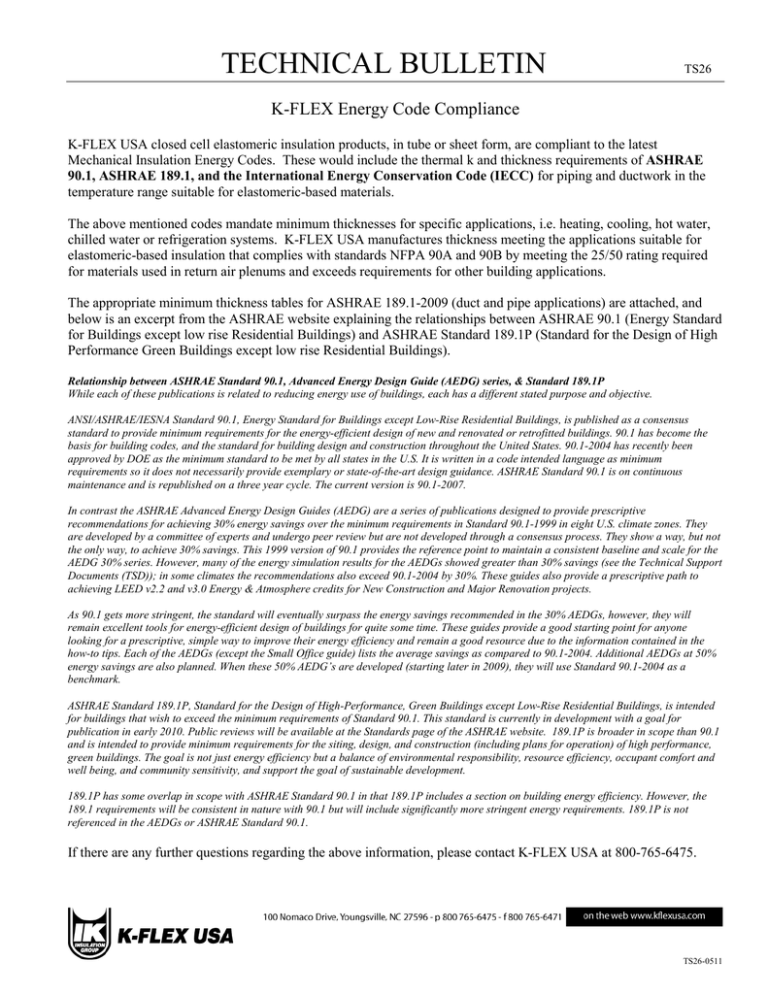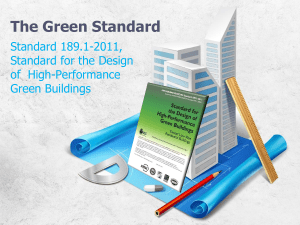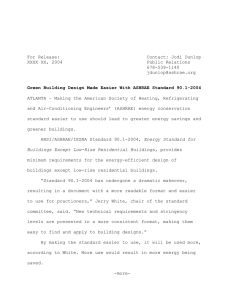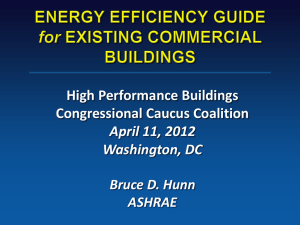TS26 Energy Code Compliance - K-Flex
advertisement

TECHNICAL BULLETIN TS26 K-FLEX Energy Code Compliance K-FLEX USA closed cell elastomeric insulation products, in tube or sheet form, are compliant to the latest Mechanical Insulation Energy Codes. These would include the thermal k and thickness requirements of ASHRAE 90.1, ASHRAE 189.1, and the International Energy Conservation Code (IECC) for piping and ductwork in the temperature range suitable for elastomeric-based materials. The above mentioned codes mandate minimum thicknesses for specific applications, i.e. heating, cooling, hot water, chilled water or refrigeration systems. K-FLEX USA manufactures thickness meeting the applications suitable for elastomeric-based insulation that complies with standards NFPA 90A and 90B by meeting the 25/50 rating required for materials used in return air plenums and exceeds requirements for other building applications. The appropriate minimum thickness tables for ASHRAE 189.1-2009 (duct and pipe applications) are attached, and below is an excerpt from the ASHRAE website explaining the relationships between ASHRAE 90.1 (Energy Standard for Buildings except low rise Residential Buildings) and ASHRAE Standard 189.1P (Standard for the Design of High Performance Green Buildings except low rise Residential Buildings). Relationship between ASHRAE Standard 90.1, Advanced Energy Design Guide (AEDG) series, & Standard 189.1P While each of these publications is related to reducing energy use of buildings, each has a different stated purpose and objective. ANSI/ASHRAE/IESNA Standard 90.1, Energy Standard for Buildings except Low-Rise Residential Buildings, is published as a consensus standard to provide minimum requirements for the energy-efficient design of new and renovated or retrofitted buildings. 90.1 has become the basis for building codes, and the standard for building design and construction throughout the United States. 90.1-2004 has recently been approved by DOE as the minimum standard to be met by all states in the U.S. It is written in a code intended language as minimum requirements so it does not necessarily provide exemplary or state-of-the-art design guidance. ASHRAE Standard 90.1 is on continuous maintenance and is republished on a three year cycle. The current version is 90.1-2007. In contrast the ASHRAE Advanced Energy Design Guides (AEDG) are a series of publications designed to provide prescriptive recommendations for achieving 30% energy savings over the minimum requirements in Standard 90.1-1999 in eight U.S. climate zones. They are developed by a committee of experts and undergo peer review but are not developed through a consensus process. They show a way, but not the only way, to achieve 30% savings. This 1999 version of 90.1 provides the reference point to maintain a consistent baseline and scale for the AEDG 30% series. However, many of the energy simulation results for the AEDGs showed greater than 30% savings (see the Technical Support Documents (TSD)); in some climates the recommendations also exceed 90.1-2004 by 30%. These guides also provide a prescriptive path to achieving LEED v2.2 and v3.0 Energy & Atmosphere credits for New Construction and Major Renovation projects. As 90.1 gets more stringent, the standard will eventually surpass the energy savings recommended in the 30% AEDGs, however, they will remain excellent tools for energy-efficient design of buildings for quite some time. These guides provide a good starting point for anyone looking for a prescriptive, simple way to improve their energy efficiency and remain a good resource due to the information contained in the how-to tips. Each of the AEDGs (except the Small Office guide) lists the average savings as compared to 90.1-2004. Additional AEDGs at 50% energy savings are also planned. When these 50% AEDG’s are developed (starting later in 2009), they will use Standard 90.1-2004 as a benchmark. ASHRAE Standard 189.1P, Standard for the Design of High-Performance, Green Buildings except Low-Rise Residential Buildings, is intended for buildings that wish to exceed the minimum requirements of Standard 90.1. This standard is currently in development with a goal for publication in early 2010. Public reviews will be available at the Standards page of the ASHRAE website. 189.1P is broader in scope than 90.1 and is intended to provide minimum requirements for the siting, design, and construction (including plans for operation) of high performance, green buildings. The goal is not just energy efficiency but a balance of environmental responsibility, resource efficiency, occupant comfort and well being, and community sensitivity, and support the goal of sustainable development. 189.1P has some overlap in scope with ASHRAE Standard 90.1 in that 189.1P includes a section on building energy efficiency. However, the 189.1 requirements will be consistent in nature with 90.1 but will include significantly more stringent energy requirements. 189.1P is not referenced in the AEDGs or ASHRAE Standard 90.1. If there are any further questions regarding the above information, please contact K-FLEX USA at 800-765-6475. TS26-0511 TECHNICAL BULLETIN TS26 ASHRAE 189.1 7.4.3.10 Duct Insulation. Duct Insulation shall comply with the minimum requirements in Tables C-9 and C-10 in Normative Appendix C. These requirements supersede the requirements in Tables 6.8.2A and 6.8.2B of ANSI/ASHRAE/IESNA Standard 90.1. 7.4.3.11 Pipe Insulation. Pipe insulation shall comply with the minimum requirements in Table C-11 in Normative Appendix C. These requirements supersede the requirements in Table 6.8.3 of ANSI/ASHRAE/IESNA Standard 90.1. The exceptions a through e in Section 6.4.4.1.3 of ANSI/ASHRAE/IESNA Standard 90.1 shall apply. TS26-0511 TECHNICAL BULLETIN TS26 TS26-0511






